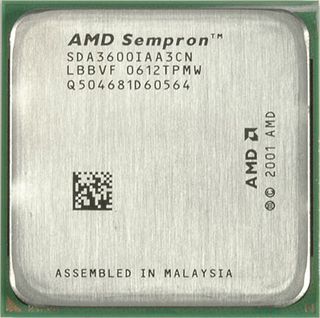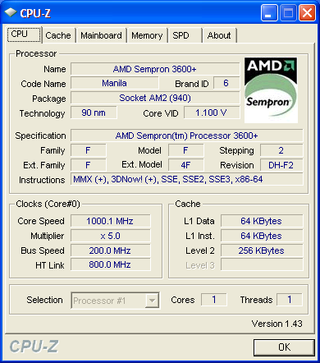AMD CPU Efficiency Compared
Processors
AMD Sempron 3600+ (Manila Core, 2.0 GHz)

The Sempron processor has had a long history with AMD. It was first introduced for Socket 754, which was the AMD64 socket for processors featuring only a single DDR memory channel. Initial versions were based on the 130 nm Paris core, but they were quickly replaced by the 90 nm Georgetown dice, at which time AMD took the chance to double the L2 cache capacity from 128 kB to 256 kB. Sempron processors at 3000+ speeds or faster also support Cool'n'Quiet. Another core update called Palermo added SSE3 and slightly faster clock speeds. Palermo was also available for Socket 939, which was the dual channel DDR platform.
With the transition to Socket AM2, AMD merged the two platforms for low-cost and high-end. Economically, this makes a lot of sense, and it matched Intel's strategy to run everything on Socket 775. AMD's Sempron for Socket AM2 was launched with 90 nm Manila cores (128 kB L2 cache first, doubled later). There is also a 65 nm low powered 45 W version called Sparta, while Manila is rated at 35 W for the upper clock speeds of up to 2.2 GHz and 35 W for 1.6 and 1.8 GHz.
The latest version we had available is based on the F2 revision Manila core, rated 3600+ (2.0 GHz). It has 256 kB L2 cache and the usual 64 kB data cache as well as 64 kB instruction cache. This processor certainly is more efficient than the Athlon 64 single core processors for Socket 754 or Socket 939, as it is based on the latest 90 nm core (62 W TDP, F2 stepping), while the 90 nm Athlon 64 CPUs used the 90 nm D0, E3, E4 and E6 steppings (rated at 67 W to 89 W TDP). As the 2.0 GHz clock speed is less than the 2.3/2.4 GHz we used for Phenom and Athlon 64 X2, the results have to be looked at with a grain of salt, and should be considered for reference.


If Cool'n'Quiet is enabled, even the low-end Sempron will reduce its core clock speed to 1.0 GHz when the CPU is idle.
Stay On the Cutting Edge: Get the Tom's Hardware Newsletter
Join the experts who read Tom's Hardware for the inside track on enthusiast PC tech news — and have for over 25 years. We'll send breaking news and in-depth reviews of CPUs, GPUs, AI, maker hardware and more straight to your inbox.
Current page: Processors
Prev Page Power Consumption Then And Now: Time To Look At AMD Next Page AMD Athlon 64 X2 4600 (Windsor F2 Core, 2.4 GHz)Most Popular



